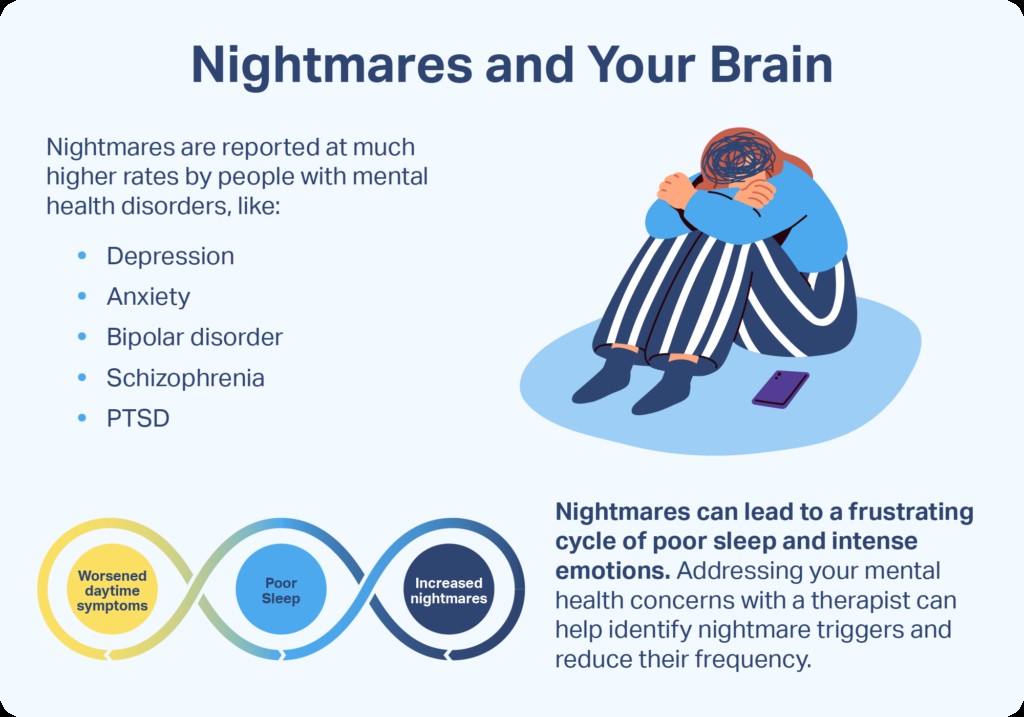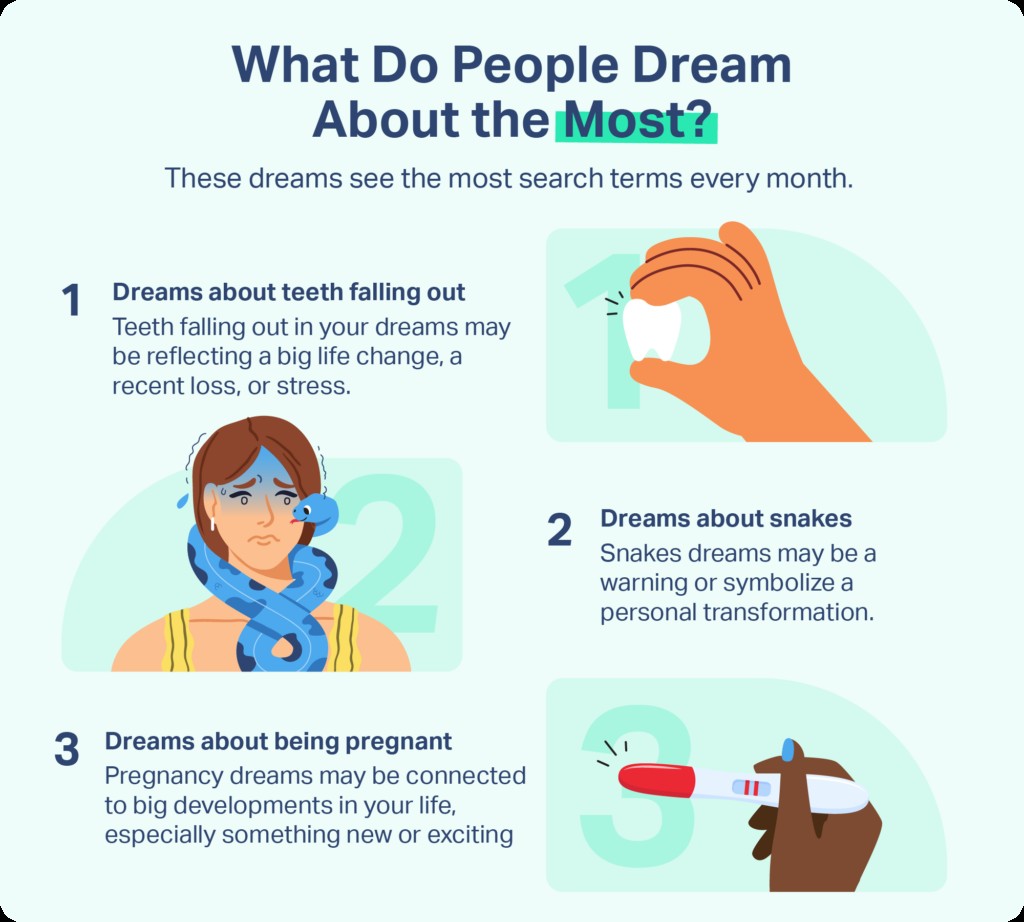Bad dreams can be unsettling, and frequent ones can disrupt your life. At WHY.EDU.VN, we’ll explore why these disturbing dreams occur and offer practical advice for better sleep and explore potential causes of bad dreams. Discover triggers and factors like stress and find out how nightmares differ from sleep terrors, as well as techniques on minimizing nightmare frequency.
1. What Exactly Are Nightmares?
In the realm of sleep medicine, nightmares possess a more precise definition than in everyday conversation. Nightmares are intense, unsettling dreams that rouse you from sleep, often inducing feelings of worry, fear, or terror. These vivid dreams can be threatening, upsetting, bizarre, or otherwise bothersome. They typically occur during rapid eye movement (REM) sleep, the stage of sleep associated with intense dreaming. Nightmares arise more frequently in the second half of the night when more time is spent in REM sleep, according to the American Academy of Sleep Medicine (AASM). Upon waking up from a nightmare, it’s normal to be acutely aware of what happened in the dream, and many people find themselves feeling upset or anxious. Physical symptoms like heart rate changes or sweating may be detected after waking up as well.
1.1. What is the difference between Nightmares and Bad Dreams?
While both nightmares and bad dreams involve disturbing dream content, only a nightmare causes you to wake up from sleep. Bad dreams, on the other hand, may be unsettling but do not disrupt your sleep cycle. It is crucial to understand the distinctions between bad dreams, nightmares, and nightmare disorder to address the underlying causes, implement appropriate treatments, and improve sleep quality. Occasional bad dreams are considered normal, but frequent nightmares that interfere with daily functioning may indicate a more significant issue.
2. Are Nightmares a Common Experience?
Occasional bad dreams and nightmares are a normal part of life for both children and adults. However, the frequency of nightmares varies across different age groups. While approximately 2% to 8% of adults experience problems with nightmares, they are more prevalent in children, particularly between the ages of 3 and 6. Nightmares tend to occur less often as children get older, but in some cases, they may persist into adolescence and adulthood.
A study published by the National Library of Medicine found that 47% of college students reported having at least one nightmare in the past two weeks. Nightmares affect both males and females, although women are generally more likely to report having nightmares, especially during adolescence through middle age, according to Elsevier.
3. What Factors Trigger Nightmares?
There is no consensus explanation for why we have nightmares, but many experts believe that dreaming is part of the mind’s methods for processing emotion and consolidating memory, according to the National Institute of Neurological Disorders and Stroke (NINDS). Bad dreams, then, may be a component of the emotional response to fear and trauma.
3.1. Stress and Anxiety
Sad, traumatic, or worrisome situations that induce stress and fear may provoke nightmares. People with chronic stress and anxiety may be more likely to develop nightmare disorder.
3.2. Mental Health Conditions
Nightmares are often reported at much higher rates by people with mental health disorders like post-traumatic stress disorder (PTSD). People with PTSD often have frequent, intense nightmares in which they relive traumatic events, worsening symptoms of PTSD, and often contributing to insomnia.
3.3. Medications and Substances
Using some types of illicit substances or prescription medications that affect the nervous system is associated with a higher risk of nightmares. Some medications suppress REM sleep, so when a person stops taking those medications, there is a short-term rebound effect of more REM sleep accompanied by more nightmares.
3.4. Sleep Deprivation
After a period of insufficient sleep, a person often experiences a REM rebound that can trigger vivid dreams and nightmares. According to the American Academy of Sleep Medicine (AASM), sleep deprivation can lead to more intense dreams and nightmares.
3.5. Genetic Predisposition
Though not fully understood, a genetic predisposition may exist that makes it more likely for frequent nightmares to run in a family. This association may be driven by genetic risk factors for mental health conditions that are tied to nightmares.
3.6. Personal History of Nightmares
In adults, a risk factor for nightmare disorder is a history of having had recurring nightmares during childhood and adolescence.
Some evidence indicates that people who have nightmares may have altered sleep architecture, meaning that they progress abnormally through sleep stages. Some studies have also found a correlation between nightmares and obstructive sleep apnea (OSA), a breathing disorder that causes fragmented sleep. However, further research is needed to clarify this association.
4. Understanding Nightmare Disorder
Nightmare disorder is a parasomnia that occurs when a person has frequent nightmares that interfere with their sleep, mood, and/or daytime functioning. While most people have nightmares from time to time, nightmare disorder is far less common. People who have occasional nightmares don’t have nightmare disorder. Instead, nightmare disorder involves recurring nightmares that bring about notable distress in their daily life.
Nightmare disorder can significantly disrupt a person’s life, leading to:
- Anxiety and fear related to sleep
- Difficulty concentrating and focusing
- Irritability and mood swings
- Daytime fatigue and sleepiness
- Impaired performance at work or school
- Social withdrawal and isolation
4.1. Nightmares vs. Sleep Terrors: What’s the Difference?
Sleep terrors, sometimes called night terrors, are another type of parasomnia in which a sleeper appears agitated and frightened during sleep. Nightmares and sleep terrors have several distinguishing characteristics, according to the National Center for Biotechnology Information:
| Feature | Nightmares | Sleep Terrors |
|---|---|---|
| Sleep Stage | REM sleep | Non-REM (NREM) sleep |
| Awakening | Full awakening; person is alert and aware of the dream | No full awakening; person remains mostly asleep and difficult to awaken; if awakened, they are likely disoriented |
| Memory of Episode | Clear memory of the dream | Very rarely any awareness of the episode |
| Time of Night | More common in the second half of the night | More common in the first half of the night |
| Emotional Response | Intense fear, anxiety, or sadness upon waking | Screaming, shouting, thrashing, and other signs of distress during the episode |
| Physical Symptoms | Rapid heart rate, sweating, trembling, and difficulty breathing upon waking | Increased heart rate, rapid breathing, dilated pupils, and sweating during the episode |
| Duration | Usually last a few minutes | Can last from a few seconds to several minutes |
| Occurrence | More common in adults and older children | More common in young children |
| Underlying Causes | Stress, anxiety, trauma, certain medications, and sleep disorders | Fever, sleep deprivation, head injuries, certain medical conditions, and genetic factors |
| Treatment Options | Psychotherapy, medication, and sleep hygiene practices | Ensuring a safe sleep environment, establishing a regular sleep schedule, and addressing any underlying medical conditions |
| Potential Risks | Sleep disruption, daytime fatigue, impaired cognitive function, and mood changes | Injury due to thrashing, sleepwalking, and other involuntary movements during the episode |
| Prevention Strategies | Managing stress, addressing underlying mental health conditions, and practicing good sleep hygiene | Avoiding sleep deprivation, establishing a relaxing bedtime routine, and ensuring a safe sleep environment |



5. How Nightmares Impact Sleep Quality
Nightmares, especially recurrent ones, can significantly affect a person’s sleep. People who experience nighttime disruptions from nightmares may wake up feeling anxious, making it hard to relax their mind and get back to sleep. As a result, the fear of nightmares may cause sleep avoidance and less time allocated to sleep. Sleep avoidance can cause sleep deprivation, which can provoke a REM sleep rebound with even more intense dreams and nightmares, according to the American Academy of Sleep Medicine (AASM) and the National Library of Medicine. This often leads to further sleep avoidance, giving rise to a pattern of disturbed sleep that culminates in insomnia.
Insufficient sleep connected to nightmares and nightmare disorder can cause:
- Excessive daytime sleepiness
- Mood changes
- Worsened cognitive function
- Substantial negative impact on a person’s daytime activities and quality of life
- Exacerbated mental health conditions that can worsen sleep
- More pronounced symptoms of conditions like depression and anxiety
6. When Should You Seek Professional Help?
While occasional nightmares are common, it’s essential to recognize when they become a cause for concern. Consider consulting a doctor about nightmares if:
- They occur more than once a week
- They affect your sleep, mood, and/or daily activity
- They begin at the same time that you start a new medication
To help your doctor understand how nightmares are affecting you, you can keep a sleep diary that tracks your total sleep and sleep disruptions, including nightmares.
7. Effective Treatment Options for Nightmare Disorder
Infrequent nightmares don’t normally need any treatment, but both psychotherapy and medications can help people who have nightmare disorder. By reducing nightmares, treatments can promote better sleep and overall health. Treatment for nightmares should always be overseen by a health professional who can identify the most appropriate therapy based on a patient’s overall health and the underlying cause of their nightmares.
7.1. Psychotherapy
Psychotherapy, also known as talk therapy, is a category of treatment that works to understand and reorient negative thinking. There are numerous types of talk therapy that may help reduce nightmares:
- Image Rehearsal Therapy: This approach involves rewriting a recurring nightmare into a script that is rewritten and then rehearsed when awake in order to change how it unfolds and impacts the sleeper.
- Lucid Dreaming Therapy: In a lucid dream, a person is actively aware that they are dreaming. Lucid dreaming therapy seizes on this idea to give a person the ability to positively modify the content of a nightmare through their awareness of it in the moment.
- Exposure and Desensitization Therapies: Because many nightmares are driven by fears, a number of approaches utilize controlled exposure to that fear to reduce the emotional reaction to it. Examples of these techniques to “face your fears” include self-exposure therapy and systematic desensitization.
- Hypnosis: This approach creates a relaxed, trance-like mental state in which a person can more easily take in positive thoughts to combat stress.
- Progressive Deep Muscle Relaxation: While not a direct form of talk therapy, progressive deep muscle relaxation is a technique for calming the mind and body. It involves deep breathing and releasing tension throughout the body. There are many audio guides available online to help lead users through the technique.
- Cognitive-Behavioral Therapy for Insomnia (CBT-I): CBT-I focuses on restructuring the thoughts, feelings, and behaviors around sleep. However, mental health professionals can tailor therapy for nightmares and, when appropriate, account for a coexisting mental health disorder.
Many types of psychotherapy also involve modifying detrimental patterns of behavior. Recommendations associated with talk therapy frequently involve changes to sleep hygiene, including daily routines and habits that facilitate consistent sleep.
7.2. Medication
Several types of prescription medications may be used to treat nightmare disorder. Most often, these are medications that affect the nervous system such as anti-anxiety, antidepressant, or antipsychotic drugs. Different medications may be used for people who have nightmares associated with PTSD. Medications benefit some patients, but they can also come with side effects. For that reason, it is important to talk with a doctor who can describe the potential benefits and downsides of prescription drugs for nightmare disorder.
8. Simple Strategies for Preventing Nightmares and Improving Sleep
Whether nightmares are common or occasional, you may get relief from improving sleep hygiene. There are many elements of sleep hygiene, but some of the most important ones, especially in the context of nightmares, include:
- Following a Consistent Sleep Schedule: Having a set bedtime and sleep schedule helps keep your sleep stable, preventing sleep avoidance and nightmare-inducing REM rebound after sleep deprivation.
- Utilizing Relaxation Methods: Finding ways to wind down, even basic deep breathing, can help decrease the stress and worry that give rise to nightmares.
- Avoiding Caffeine and Alcohol: Caffeine can stimulate your mind, which makes it harder to relax and fall asleep. Drinking alcohol close to bedtime can induce a REM rebound in the second half of the night that may worsen nightmares. As much as possible, it’s best to avoid alcohol and caffeine in the evening.
- Reducing Screen Time Before Bed: Using a smartphone, tablet, or laptop before bed can amp up your brain activity and make it difficult to fall asleep. If the screen time involves negative or worrying imagery, it may make nightmares more likely. To avoid this, create a bedtime routine with no screen time for an hour or more before going to sleep.
- Creating a Comforting Sleep Environment: Your bedroom should promote a sense of calm with as few distractions or disruptions as possible. Set a comfortable temperature, block out excess light and sound, and set up your bed and bedding to be supportive and inviting.
Building better sleep habits is a component of many therapies for nightmare disorder and can pave the way for high-quality sleep on a regular basis. If you have persistent nightmares that interfere with your daily life, the first step is to talk with your doctor. Identifying and addressing an underlying cause can help make nightmares less frequent and less bothersome.
9. Addressing Common Questions About Nightmares (FAQ)
9.1. Can certain foods trigger nightmares?
While research is limited, some individuals report that eating spicy foods or large meals close to bedtime can trigger nightmares. These foods may disrupt sleep patterns and increase body temperature, potentially leading to more vivid and disturbing dreams.
9.2. Are nightmares more common during certain times of the year?
Anecdotal evidence suggests that nightmares may be more frequent during times of stress or emotional upheaval, such as holidays or major life events. Seasonal changes and disruptions to sleep schedules can also contribute to increased nightmare occurrence.
9.3. Can children outgrow nightmares?
Nightmares are a common occurrence in childhood, particularly between the ages of 3 and 6. As children mature, their brains develop more effective coping mechanisms for processing emotions and experiences, which can lead to a decrease in the frequency and intensity of nightmares. However, some children may continue to experience nightmares into adolescence and adulthood.
9.4. Is there a link between nightmares and creativity?
Some researchers believe that there may be a connection between nightmares and creativity. Nightmares can be intense and emotionally charged experiences, which may stimulate the imagination and lead to creative insights. However, more research is needed to fully understand this relationship.
9.5. Can nightmares be a sign of a deeper psychological issue?
While occasional nightmares are typically not a cause for concern, frequent and distressing nightmares can be a symptom of an underlying psychological issue, such as post-traumatic stress disorder (PTSD), anxiety disorders, or depression. If nightmares are significantly impacting your daily life, it is important to seek professional help.
9.6. Are there any cultural beliefs or superstitions surrounding nightmares?
Nightmares have been the subject of various cultural beliefs and superstitions throughout history. In some cultures, nightmares are believed to be caused by evil spirits or demons. Other cultures believe that nightmares are a way for the subconscious mind to process unresolved emotions or traumas.
9.7. Can nightmares be contagious?
Nightmares are not contagious in the traditional sense, but sharing a living space with someone who experiences frequent nightmares can be unsettling. The fear and anxiety associated with nightmares can be contagious, leading to increased stress and sleep disturbances for others in the household.
9.8. Are there any support groups or online communities for people who experience nightmares?
Yes, there are several support groups and online communities for people who experience nightmares. These communities provide a safe and supportive space for individuals to share their experiences, connect with others, and learn coping strategies for managing nightmares.
9.9. Can pets have nightmares?
Yes, pets can have nightmares. Like humans, animals experience REM sleep, which is the stage of sleep associated with dreaming. Signs of a nightmare in pets may include whimpering, twitching, or thrashing in their sleep.
9.10. Are there any natural remedies for nightmares?
Several natural remedies may help reduce the frequency and intensity of nightmares. These remedies include practicing relaxation techniques, maintaining a regular sleep schedule, avoiding caffeine and alcohol before bed, and creating a comforting sleep environment. However, it is important to consult with a healthcare professional before trying any new remedies, especially if you have underlying health conditions.
Navigating the world of nightmares can be complex, but understanding their causes and available treatments can empower you to take control of your sleep and overall well-being.
If you’re struggling with persistent nightmares and finding it difficult to get answers or expert guidance, remember that WHY.EDU.VN is here to help. Our platform offers a wealth of information and connects you with experts who can provide personalized support.
Don’t let nightmares disrupt your life any longer. Visit WHY.EDU.VN today at our physical address located at 101 Curiosity Lane, Answer Town, CA 90210, United States or contact us via Whatsapp at +1 (213) 555-0101 and start your journey toward peaceful, restorative sleep. Let us help you uncover the answers you need and connect with experts who can provide tailored solutions. With why.edu.vn, you’re not alone in your quest for better sleep and a brighter tomorrow.
